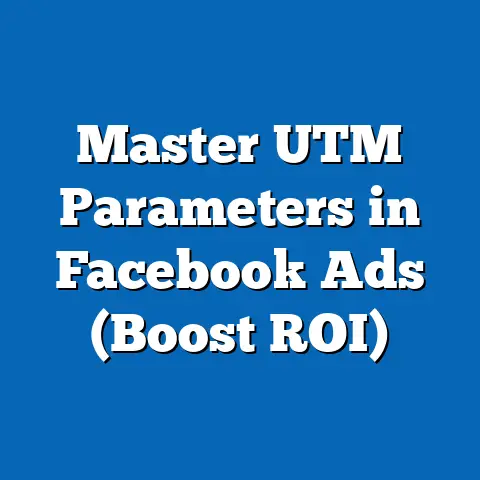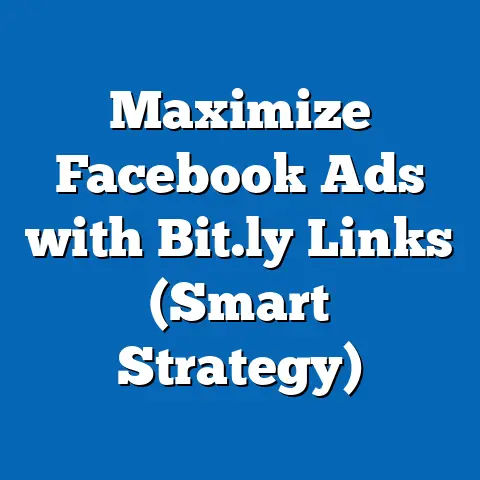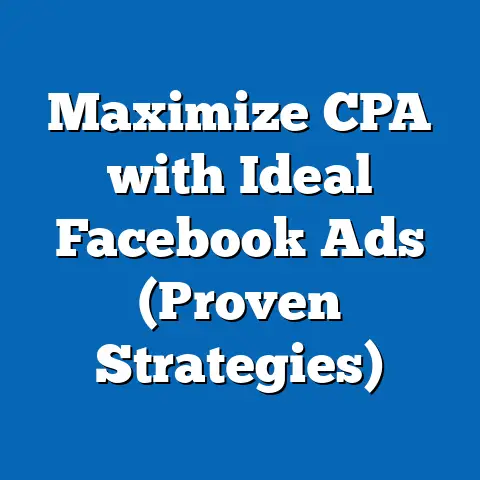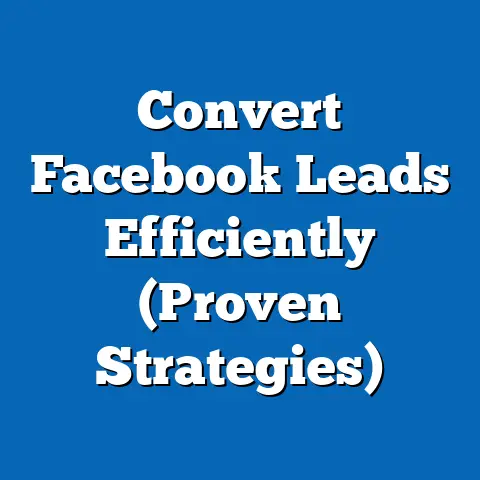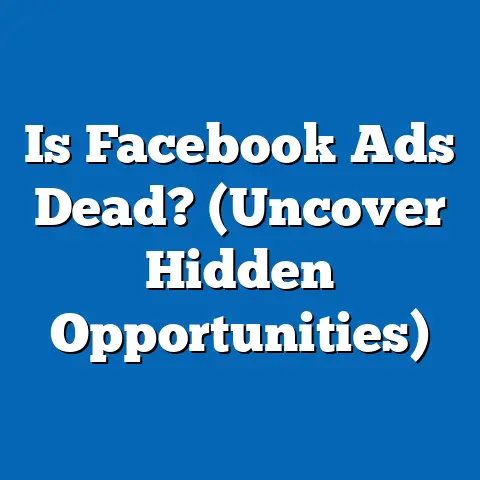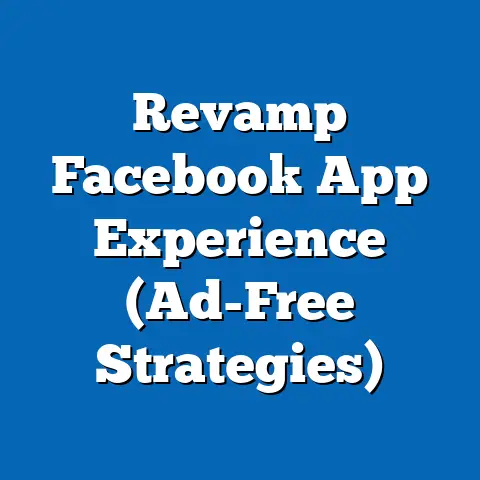Why Facebook Ads Dominate Feed (Insightful Analysis)
The digital world is in constant flux. I’ve seen firsthand how technology continues to evolve at an unprecedented pace, reshaping almost every aspect of our lives, particularly how businesses connect with their customers. Think back to the early days of the internet – static banner ads were the height of innovation. Today, we live in a world dominated by social media, personalized content, and sophisticated advertising platforms, and at the heart of this revolution lies Facebook.
Facebook, with its massive user base and incredibly detailed targeting capabilities, has become an advertising powerhouse. As of 2023, Facebook boasts nearly 3 billion monthly active users. That’s almost half the world’s population! This sheer scale alone makes it a prime location for businesses to reach potential customers. But it’s not just the size; it’s the depth of information Facebook holds about its users, allowing advertisers to pinpoint their ideal audience with laser-like precision.
I remember when I first started delving into Facebook advertising. I was overwhelmed by the sheer complexity of the platform, the endless options for targeting, and the ever-changing algorithms. However, over time, I came to appreciate the power and potential that Facebook offers to businesses of all sizes. Whether you’re a small local bakery or a large multinational corporation, Facebook provides the tools and resources to connect with your target audience in a meaningful way.
The Key Takeaways:
Before we dive into the details, let’s outline the key takeaways that will be explored in this article:
- Evolution of Digital Advertising: Understanding the transition from traditional to digital advertising and Facebook’s pivotal role.
- Mechanics of Facebook Ads: How Facebook’s advertising platform works, including targeting, ad formats, and bidding strategies.
- Targeting Capabilities: Analyzing Facebook’s advanced targeting options and their impact on campaign success.
- Data and Analytics: The importance of data in enhancing ad performance and user experience on Facebook.
- User Engagement: How user engagement influences ad visibility and effectiveness.
- Competitive Landscape: Comparing Facebook ads with advertising on competing platforms and understanding Facebook’s unique advantages.
The Evolution of Digital Advertising
To truly appreciate Facebook’s dominance, it’s crucial to understand the evolution of digital advertising. I’ve witnessed this transformation firsthand, from the early days of simple banner ads to the sophisticated, data-driven strategies of today.
From Banner Ads to Social Media Marketing
In the beginning, digital advertising was a wild west of flashing banners and pop-up ads. These early forms of online advertising were often disruptive and ineffective, leading to what we now call “banner blindness.” Users quickly learned to ignore these ads, rendering them largely useless.
The rise of search engines like Google marked a significant shift. Search engine marketing (SEM) allowed advertisers to target users based on their search queries, making ads more relevant and effective. However, SEM still relied on users actively searching for products or services.
Social media marketing revolutionized the game by allowing advertisers to reach users based on their interests, demographics, and behaviors, even when they weren’t actively searching for something. This shift from “pull” to “push” marketing opened up new possibilities for businesses to connect with their target audience.
The Shift in Consumer Behavior
Consumer behavior has changed drastically with the rise of digital platforms. People now spend a significant portion of their time online, particularly on social media. According to Statista, the average person spends over two hours per day on social media. This presents a huge opportunity for businesses to reach potential customers where they are already spending their time.
Moreover, consumers are increasingly influenced by online reviews, social media recommendations, and influencer marketing. They are more likely to trust the opinions of their friends and peers than traditional advertising messages. This has led to a greater emphasis on building authentic relationships with customers and creating engaging content that resonates with them.
Facebook’s Role in the Transformation
Facebook has been at the forefront of this transformation. Its ability to collect and analyze user data has allowed advertisers to create highly targeted and personalized ads. Facebook’s advertising platform has evolved from simple display ads to sophisticated campaigns that integrate video, interactive content, and even augmented reality.
According to eMarketer, Facebook accounts for a significant portion of total digital ad spending. In 2022, Facebook’s ad revenue reached over $117 billion, demonstrating its continued dominance in the digital advertising landscape.
Key Takeaway: The evolution of digital advertising has been driven by changes in consumer behavior and technological advancements. Facebook has played a pivotal role in this transformation by providing businesses with powerful tools to reach and engage with their target audience.
The Mechanics of Facebook Ads
Understanding the mechanics of Facebook ads is essential to leveraging the platform effectively. I’ve spent countless hours navigating the intricacies of Facebook’s advertising platform, and I can tell you that it’s both powerful and complex.
Key Features of Facebook’s Advertising Platform
Facebook’s advertising platform is built around several key features that enable businesses to create and manage effective ad campaigns:
- Targeting Options: Facebook’s targeting options are incredibly granular, allowing advertisers to reach users based on demographics, interests, behaviors, and connections.
- Ad Formats: Facebook offers a variety of ad formats, including image ads, video ads, carousel ads, and collection ads, each designed to achieve different marketing objectives.
- Bidding Strategies: Facebook allows advertisers to choose from a variety of bidding strategies, including cost per click (CPC), cost per impression (CPM), and cost per acquisition (CPA), to optimize their ad spend.
- Ad Placement: Facebook ads can be placed in various locations, including the Facebook feed, Instagram feed, Messenger, and Audience Network.
- Ad Manager: Facebook’s Ad Manager provides a centralized platform for creating, managing, and tracking ad campaigns.
Understanding the Facebook Algorithm
The Facebook algorithm plays a crucial role in determining which ads are shown to users. The algorithm prioritizes ads based on several factors, including:
- Relevance: Ads that are relevant to the user’s interests and behaviors are more likely to be shown.
- Engagement: Ads that generate high levels of engagement (likes, comments, shares) are given higher priority.
- Bid Amount: Advertisers who bid higher are more likely to have their ads shown.
- Ad Quality: Facebook evaluates the quality of ads based on factors such as image quality, ad copy, and landing page experience.
I’ve learned that creating high-quality, engaging ads that are relevant to your target audience is the key to success on Facebook. By understanding how the algorithm works, you can optimize your ads to achieve better results.
Ad Formats: Choosing the Right Option
Facebook offers a variety of ad formats, each designed to achieve different marketing objectives. Here’s a brief overview of some of the most popular ad formats:
- Image Ads: Simple image ads are a great way to showcase your product or service. They are easy to create and can be highly effective when paired with compelling visuals and ad copy.
- Video Ads: Video ads are more engaging than image ads and can be used to tell a story, demonstrate a product, or share a testimonial.
- Carousel Ads: Carousel ads allow you to showcase multiple images or videos in a single ad unit. This format is ideal for showcasing a range of products or highlighting different features of a single product.
- Collection Ads: Collection ads are designed to drive sales by allowing users to browse and purchase products directly from the ad.
- Lead Ads: Lead ads make it easy for users to sign up for your email list or request more information. These ads are particularly effective for lead generation.
Key Takeaway: Understanding the mechanics of Facebook ads, including targeting options, ad formats, bidding strategies, and the Facebook algorithm, is crucial for creating effective ad campaigns.
Targeting Capabilities: A Key to Success
Facebook’s advanced targeting options are a key reason why its ads are so effective. I’ve seen firsthand how businesses can use these targeting options to reach their ideal audience with incredible precision.
Demographic, Geographic, and Psychographic Targeting
Facebook allows advertisers to target users based on a wide range of demographic, geographic, and psychographic factors.
- Demographic Targeting: Target users based on age, gender, education, relationship status, job title, and more.
- Geographic Targeting: Target users based on their location, down to the city or zip code level.
- Psychographic Targeting: Target users based on their interests, behaviors, and opinions.
I once worked with a local bookstore that wanted to promote a new series of mystery novels. We used Facebook’s demographic targeting to reach users aged 35-65 who had an interest in reading and mystery novels. We also used geographic targeting to focus our ads on people living within a 10-mile radius of the bookstore. The campaign was incredibly successful, resulting in a significant increase in sales of the mystery novels.
Audience Segmentation
Audience segmentation is the process of dividing your target audience into smaller groups based on shared characteristics. This allows you to tailor your ads to the specific needs and interests of each segment.
Facebook offers several tools for audience segmentation, including:
- Custom Audiences: Create custom audiences based on your existing customer data, such as email lists or website visitors.
- Lookalike Audiences: Create lookalike audiences based on your custom audiences. Facebook will identify users who share similar characteristics with your existing customers.
- Saved Audiences: Save your targeting criteria for future use.
Successful Campaigns Leveraging Facebook’s Targeting Features
Many successful campaigns have leveraged Facebook’s targeting features to achieve remarkable results. For example, Airbnb used Facebook’s targeting options to reach travelers who were interested in unique accommodations. They targeted users who had expressed an interest in travel, adventure, and local experiences. The campaign was highly successful, driving a significant increase in bookings.
Key Takeaway: Facebook’s advanced targeting options are a powerful tool for reaching your ideal audience. By understanding how to use demographic, geographic, and psychographic targeting, as well as audience segmentation, you can create highly effective ad campaigns.
The Role of Data and Analytics
Data and analytics are essential for measuring the effectiveness of your Facebook ad campaigns and optimizing them for better results. I’ve learned that tracking the right metrics and analyzing the data is crucial for achieving a positive return on investment.
How Facebook Collects and Utilizes Data
Facebook collects a vast amount of data about its users, including their demographics, interests, behaviors, and connections. This data is used to personalize the user experience and to provide advertisers with valuable insights into their target audience.
Facebook collects data through several channels, including:
- User Profiles: Users voluntarily provide information about themselves when creating their Facebook profiles.
- Activity Tracking: Facebook tracks users’ activity on the platform, including the pages they like, the groups they join, and the content they share.
- Website Tracking: Facebook’s Pixel allows advertisers to track users’ activity on their websites, including the pages they visit, the products they view, and the purchases they make.
- App Tracking: Facebook tracks users’ activity on mobile apps through its Mobile SDK.
This data is used to create highly targeted ad campaigns and to measure the effectiveness of those campaigns.
Significance of Analytics in Measuring Ad Effectiveness
Analytics are essential for measuring the effectiveness of your Facebook ad campaigns. By tracking key metrics, you can identify what’s working and what’s not, and make adjustments to optimize your campaigns for better results.
Some of the most important metrics to track include:
- Click-Through Rate (CTR): The percentage of users who click on your ad.
- Conversion Rate: The percentage of users who take a desired action, such as making a purchase or signing up for your email list.
- Cost Per Click (CPC): The average cost you pay each time someone clicks on your ad.
- Cost Per Acquisition (CPA): The average cost you pay each time someone takes a desired action.
- Return on Ad Spend (ROAS): The amount of revenue you generate for every dollar you spend on advertising.
I always advise my clients to set up conversion tracking to accurately measure the results of their campaigns. Without conversion tracking, it’s impossible to know whether your ads are actually driving sales or leads.
Tools for Tracking Performance and Optimizing Campaigns
Facebook offers several tools for tracking performance and optimizing your ad campaigns:
- Facebook Ads Manager: The Ads Manager provides a centralized platform for creating, managing, and tracking your ad campaigns.
- Facebook Analytics: Facebook Analytics allows you to track user behavior on your website and mobile app.
- Google Analytics: Google Analytics can be integrated with Facebook to provide a more comprehensive view of your website traffic and user behavior.
Key Takeaway: Data and analytics are essential for measuring the effectiveness of your Facebook ad campaigns and optimizing them for better results. By tracking key metrics and using the tools available, you can make data-driven decisions that improve your ROI.
The Impact of User Engagement on Ad Dominance
User engagement plays a crucial role in determining the visibility and effectiveness of your Facebook ads. I’ve seen firsthand how ads that generate high levels of engagement are more likely to be shown to users and to drive positive results.
How User Engagement Influences Ad Visibility
Facebook’s algorithm prioritizes ads that generate high levels of engagement. This means that ads that receive a lot of likes, comments, and shares are more likely to be shown to users.
User engagement signals to Facebook that your ad is relevant and interesting to users. This increases the likelihood that your ad will be shown to a wider audience.
The Role of User-Generated Content
User-generated content (UGC) can be a powerful tool for enhancing ad reach and engagement. UGC includes content created by users, such as reviews, testimonials, and photos.
By incorporating UGC into your ads, you can build trust and credibility with potential customers. UGC is often seen as more authentic and trustworthy than traditional advertising messages.
I worked with a restaurant that encouraged customers to share photos of their meals on Facebook. We then used these photos in our ads, which generated a significant increase in engagement and reservations.
Case Studies of Successful Brands
Many successful brands have created engaging content that resonates with their audience. For example, Dove’s “Real Beauty” campaign challenged traditional beauty standards and celebrated the diversity of women. The campaign generated a huge amount of engagement and helped to build a strong brand identity.
Another example is GoPro, which encourages users to share their adventure videos on social media. GoPro then features these videos in their ads, showcasing the capabilities of their products and inspiring others to pursue their passions.
Key Takeaway: User engagement is crucial for the visibility and effectiveness of your Facebook ads. By creating engaging content and incorporating user-generated content, you can build trust and credibility with potential customers and drive positive results.
Competitors and Market Positioning
While Facebook dominates the social media advertising landscape, it’s important to consider its competitors and market positioning. I’ve analyzed the strengths and weaknesses of various platforms, and I can tell you that each has its unique advantages and disadvantages.
Comparing Facebook Ads with Advertising on Competing Platforms
Facebook faces competition from several other advertising platforms, including:
- Instagram: Instagram is owned by Facebook and shares many of the same advertising features. However, Instagram is more visually focused and appeals to a younger audience.
- Twitter: Twitter is a microblogging platform that allows users to share short messages. Twitter ads can be effective for driving brand awareness and generating leads.
- Google Ads: Google Ads allows advertisers to reach users based on their search queries. Google Ads can be highly effective for driving traffic to your website and generating sales.
- LinkedIn: LinkedIn is a professional networking platform that allows advertisers to reach users based on their job title, industry, and company. LinkedIn ads are particularly effective for B2B marketing.
Facebook’s Unique Advantages
Despite the competition, Facebook has several unique advantages that contribute to its dominance:
- Massive User Base: Facebook has the largest user base of any social media platform, providing advertisers with access to a vast audience.
- Detailed Targeting Options: Facebook’s targeting options are incredibly granular, allowing advertisers to reach their ideal audience with precision.
- Variety of Ad Formats: Facebook offers a variety of ad formats, each designed to achieve different marketing objectives.
- Integrated Platform: Facebook’s integrated platform allows advertisers to reach users across multiple channels, including Facebook, Instagram, Messenger, and Audience Network.
Challenges and Competition
Despite its dominance, Facebook faces several challenges and competition in the ever-evolving digital landscape:
- Privacy Concerns: Facebook has faced criticism over its data privacy practices, which has led to increased regulation and user skepticism.
- Algorithm Changes: Facebook’s algorithm is constantly changing, which can make it difficult for advertisers to maintain consistent results.
- Emerging Platforms: New social media platforms are constantly emerging, which could potentially disrupt Facebook’s dominance in the future.
Key Takeaway: While Facebook faces competition from other advertising platforms, its massive user base, detailed targeting options, variety of ad formats, and integrated platform give it a unique advantage in the digital advertising landscape.
Conclusion
In conclusion, Facebook’s dominance in the advertising space is a result of several factors, including its vast user base, advanced targeting options, variety of ad formats, and integrated platform. I’ve seen firsthand how businesses can leverage these advantages to reach their ideal audience and achieve remarkable results.
However, it’s important to remember that the digital landscape is constantly evolving. Facebook faces challenges from privacy concerns, algorithm changes, and emerging platforms. To maintain its dominance, Facebook must continue to innovate and adapt to the changing needs of users and advertisers.
As technology continues to advance, the future of Facebook ads is likely to involve even more personalized and immersive experiences. I believe that augmented reality, virtual reality, and artificial intelligence will play an increasingly important role in shaping the future of digital advertising.
The journey of digital advertising is far from over, and I’m excited to see what the future holds. By understanding the factors that contribute to Facebook’s dominance and staying up-to-date with the latest trends and technologies, you can position your business for success in the ever-evolving digital landscape.

